Citroen C1 RHD 2016 1.G Owner's Manual
Manufacturer: CITROEN, Model Year: 2016, Model line: C1 RHD, Model: Citroen C1 RHD 2016 1.GPages: 268, PDF Size: 7.09 MB
Page 131 of 268

129
Child seats recommended by CITROËN
Group 0+: from bir th to 13 kgGroups 2 and 3: from 15 to 36 kg
L1
"RÖMER
Baby-Safe Plus"
I
nstalled in the rear ward facing position. L4
"KLIPPAN
Optima"
From
22 kg (approximately 6 years),
the
booster is used on its own.L5
"RÖMER KIDFIX"
Can
be fitted to the vehicle's ISOFIX mountings.
The
child is restrained by the seat belt.
CITROËN
offers a range of recommended child seats which are secured using a three point seat
belt .
6
Safety
Page 132 of 268
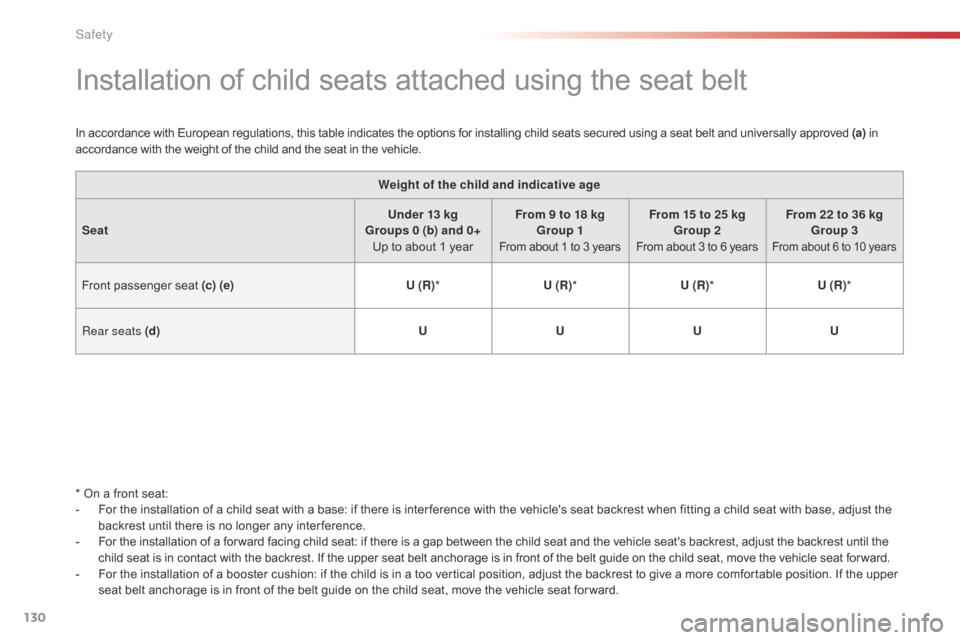
130
Installation of child seats attached using the seat belt
In accordance with European regulations, this table indicates the options for installing child seats secured using a seat belt and universally approved (a) in
accordance with the weight of the child and the seat in the vehicle.
Weight of the child and indicative age
Seat Under 13 kg
Groups 0 (b) and 0+ Up
to about 1 yearFrom 9 to 18 kg
Group 1
From
about 1 to 3 yearsFrom 15 to 25 kg
Group 2
From
about 3 to 6 yearsFrom 22 to 36 kg
Group 3
From about 6 t o 1 0 ye ars
Front passenger sea t ( c) (e) U (R)* U (R)* U (R)* U (R)*
Rear seats (d) UUUU
*
On a front seat:
-
F
or the installation of a child seat with a base: if there is inter ference with the vehicle's seat backrest when fitting a child seat with base, adjust the
b
ackrest until there is no longer any inter ference.
-
F
or the installation of a for ward facing child seat: if there is a gap between the child seat and the vehicle seat's backrest, adjust the backrest until the
c
hild seat is in contact with the backrest. If the upper seat belt anchorage is in front of the belt guide on the child seat, move the vehicle seat for ward.
-
F
or the installation of a booster cushion: if the child is in a too vertical position, adjust the backrest to give a more comfortable position. If the upper
s
eat belt anchorage is in front of the belt guide on the child seat, move the vehicle seat for ward.
Safety
Page 133 of 268
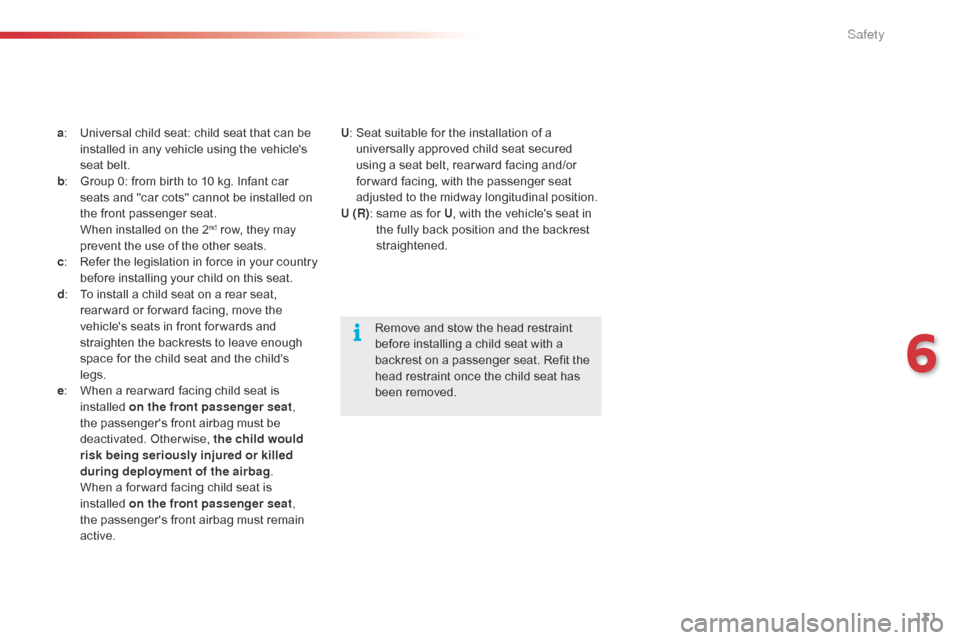
131
a: Universal child seat: child seat that can be i
nstalled in any vehicle using the vehicle's
s
eat belt.
b :
G
roup 0: from birth to 10 kg. Infant car
s
eats and "car cots" cannot be installed on
t
he
f
ront
p
assenger
sea
t.
W
hen installed on the 2
nd row, they may p
revent
the
use
of
the
other seats.
c :
R
efer
t
he
l
egislation
i
n
f
orce
i
n
y
our
c
ountry
b
efore
installing
your
child on this seat.
d :
T
o
install
a
child
seat
on
a rear seat,
r
ear ward
or
for ward
facing, move the
v
ehicle's
seats
in
front
for wards and
s
traighten
the
backrests
to leave enough
s
pace
for
the
child
seat
and the child's
l
egs.
e :
W
hen
a
rear ward
facing
child seat is
i
nstalled
o
n the front passenger seat ,
the
passenger's
front
airbag must be
d
eactivated.
O
therwise,
t
he child would
risk being seriously injured or killed
during deployment of the airbag .
W
hen
a
for ward
facing
child seat is
i
nstalled
o
n the front passenger seat ,
the
passenger's
front
airbag must remain
a
ctive. Remove
and stow the head restraint
b
efore installing a child seat with a
b
ackrest on a passenger seat. Refit the
h
ead restraint once the child seat has
b
een removed.
U
:
S
eat suitable for the installation of a
u
niversally approved child seat secured
u
sing a seat belt, rear ward facing and/or
f
or ward facing, with the passenger seat
a
djusted to the midway longitudinal position.
U (R) :
s
ame as for U
, with the vehicle's seat in t
he fully back position and the backrest s
traightened.
6
Safety
Page 134 of 268
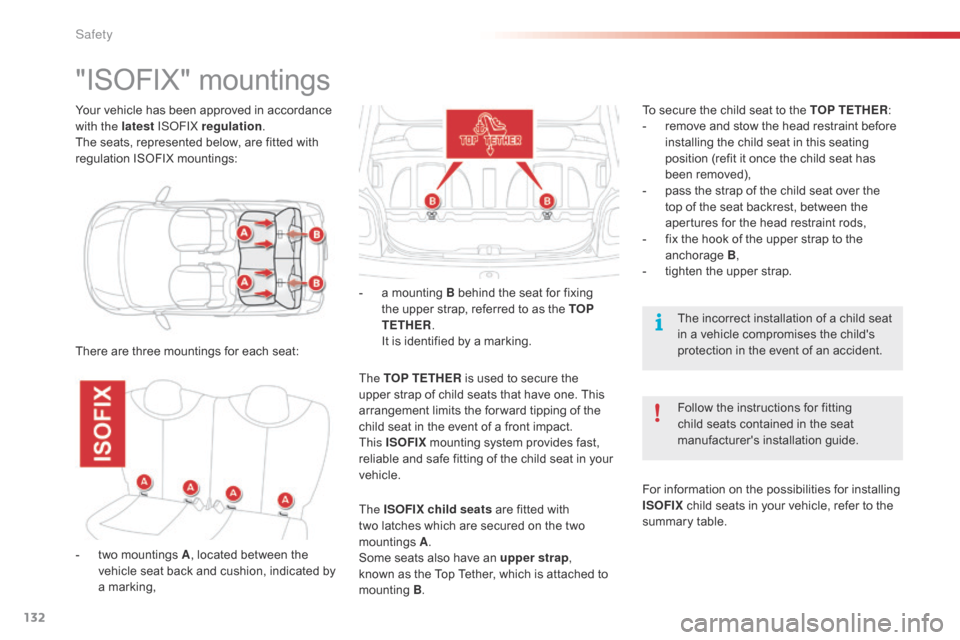
132
Your vehicle has been approved in accordance with the latest ISOFIX regulation .
The
seats, represented below, are fitted with
r
egulation
I
SOFIX
m
ountings:
"ISOFIX" mountings
There are three mountings for each seat: -
a
mounting B behind the seat for fixing
t
he upper strap, referred to as the TOP
TETHER . I t is identified by a marking.
The TOP TETHER is used to secure the
u
pper strap of child seats that have one. This
a
rrangement limits the for ward tipping of the
c
hild seat in the event of a front impact.
This ISOFIX
mounting system provides fast,
r
eliable and safe fitting of the child seat in your
v
ehicle. Follow
the instructions for fitting
c
hild seats contained in the seat
m
anufacturer's installation guide.
The
incorrect installation of a child seat
i
n a vehicle compromises the child's p
rotection in the event of an accident.
The ISOFIX child seats are fitted with
t
wo latches which are secured on the two
m
ountings
A.
S
ome seats also have an upper strap,
known
as the Top Tether, which is attached to
m
ounting
B. T
o secure the child seat to the TOP TETHER
:
-
r
emove and stow the head restraint before
i
nstalling the child seat in this seating
p
osition (refit it once the child seat has
b
een removed),
-
p
ass the strap of the child seat over the
t
op of the seat backrest, between the
a
pertures for the head restraint rods,
-
f
ix the hook of the upper strap to the
anc
horage
B
,
-
t
ighten the upper strap.
For information on the possibilities for installing
I
SOFIX
child seats in your vehicle, refer to the
s
ummary table.
-
t
wo mountings A,
located between the
v
ehicle seat back and cushion, indicated by
a
marking,
Safety
Page 135 of 268
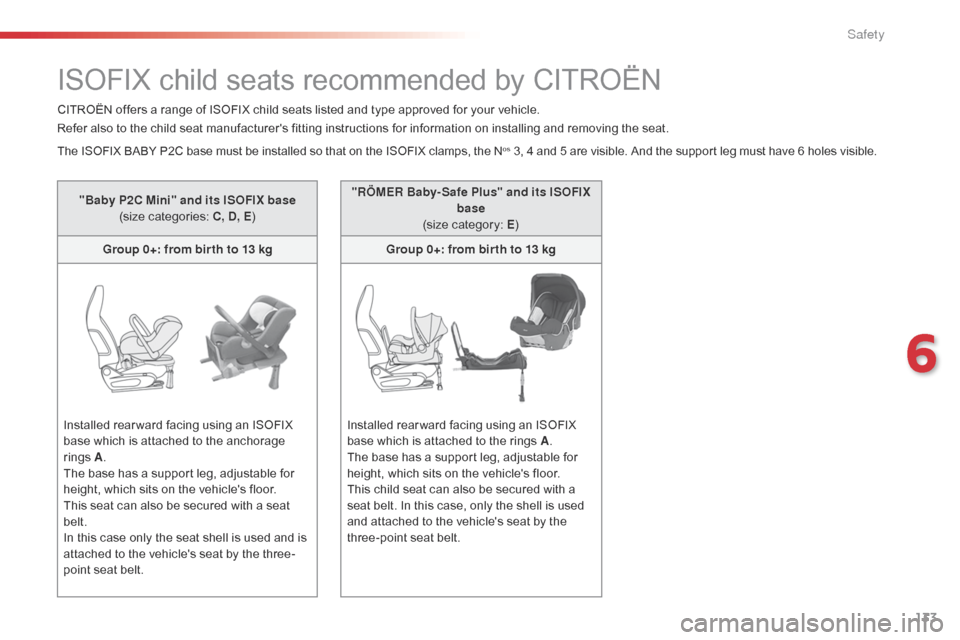
133
"Baby P2C Mini" and its ISOFIX base(size c ategories: C , D, E)
Group 0+: from bir th to 13 kg
Installed
rear ward facing using an ISOFIX
b
ase which is attached to the anchorage
r
ings
A .
T
he base has a support leg, adjustable for
h
eight, which sits on the vehicle's floor.
This
seat can also be secured with a seat
bel
t.
In
this case only the seat shell is used and is
a
ttached to the vehicle's seat by the three-
point
seat belt.
ISOFIX child seats recommended by CITROËN
CITROËN offers a range of ISOFIX child seats listed and type approved for your vehicle.
R efer also to the child seat manufacturer's fitting instructions for information on installing and removing the seat.
The
ISOFIX BABY P2C base must be installed so that on the ISOFIX clamps, the N
os 3, 4 and 5 are visible. And the support leg must have 6 holes visible.
"
RÖMER Baby- Safe Plus" and its ISOFIX base
(size
category:
E )
Group 0+: from bir th to 13 kg
Installed
rear ward
facing
using an ISOFIX
b
ase
which
is
attached
to
the
rings A.
The
base
has
a
support
leg,
adjustable for
h
eight,
which
sits
on
the
vehicle's floor.
This
child
seat
can
also
be
secured with a
s
eat
belt.
In
this
case,
only
the shell is used
a
nd
attached
to
the
vehicle's
seat by the
t
hree-point
seat
belt.
6
Safety
Page 136 of 268
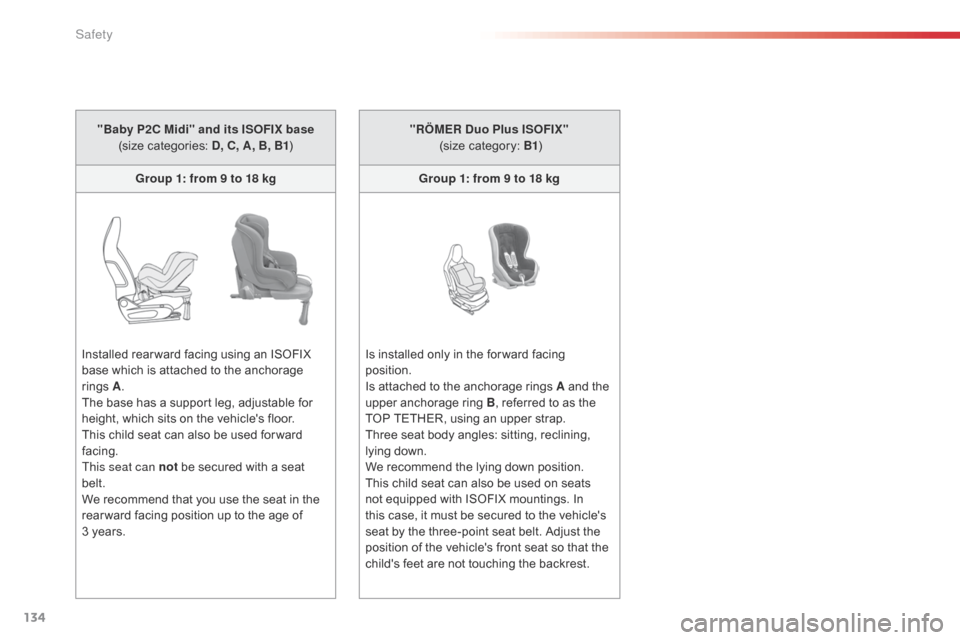
134
"Baby P2C Midi" and its ISOFIX base (size categories: D , C, A, B, B1)
Group 1: from 9 to 18 kg
Installed
rear ward facing using an ISOFIX
b
ase which is attached to the anchorage
r
ings
A .
T
he base has a support leg, adjustable for
h
eight, which sits on the vehicle's floor.
This
child seat can also be used for ward
f
acing.
This seat can not
be secured with a seat
bel
t.
We
recommend that you use the seat in the
r
ear ward facing position up to the age of
3 ye
ars. "RÖMER Duo Plus ISOFIX"
(size category: B1)
Group 1: from 9 to 18 kg
Is
installed only in the for ward facing
p
osition.
Is
attached to the anchorage rings A and the
u
pper anchorage ring B,
referred to as the
T
OP TETHER, using an upper strap.
Three
seat body angles: sitting, reclining,
l
ying down.
We
recommend the lying down position.
This
child seat can also be used on seats
n
ot equipped with ISOFIX mountings. In
t
his case, it must be secured to the vehicle's
s
eat by the three-point seat belt. Adjust the
p
osition of the vehicle's front seat so that the
c
hild's feet are not touching the backrest.
Safety
Page 137 of 268
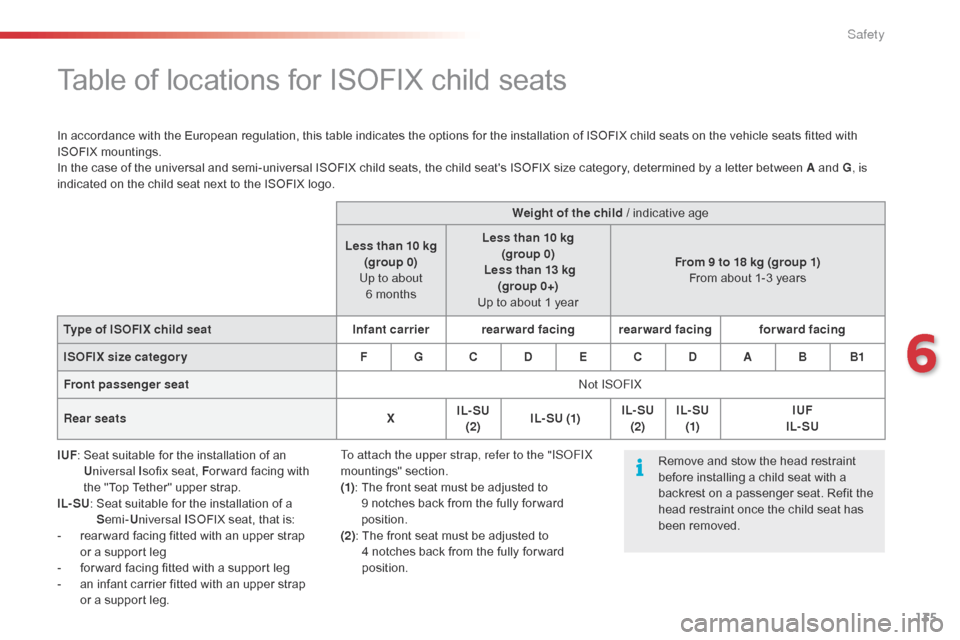
135
Table of locations for ISOFIX child seats
In accordance with the European regulation, this table indicates the options for the installation of ISOFIX child seats on the vehicle seats fitted with ISOFIX m ountings.
In
the case of the universal and semi-universal ISOFIX child seats, the child seat's ISOFIX size category, determined by a letter between A and G, is
indicated
on the child seat next to the ISOFIX logo.
IUF :
S
eat suitable for the installation of an
Un
iversal I sofix
seat, For ward
facing with
t
he "Top Tether" upper strap.
IL- SU :
S
eat suitable for the installation of a
Se
mi-Universal I SOFIX
seat, that is:
-
r
ear ward facing fitted with an upper strap
o
r a support leg
-
f
or ward facing fitted with a support leg
-
a
n infant carrier fitted with an upper strap
o
r a support leg. Weight of the child
/ indicative age
Less than 10 kg (group 0)
Up to about 6 months Less than 10 kg
(group 0)
Less than 13 kg (group 0+)
Up
to about 1 yearFrom 9 to 18 kg (group 1)
From
about 1-3 years
Type of ISOFIX child seat Infant carrierrearward facing rearward facing forward facing
ISOFIX size categor y F G C D E C D A B B1
Front passenger seat Not ISOFIX
Rear seats XIL- SU
(2) I L- SU (1) IL- SU
(2) IL- SU
(1) IUF
IL- SU
Remove
and stow the head restraint
b
efore installing a child seat with a
b
ackrest on a passenger seat. Refit the
h
ead restraint once the child seat has
b
een removed.
To attach the upper strap, refer to the "ISOFIX
mountings"
se
ction.
(1) :
T
he front seat must be adjusted to
9
notches back from the fully for ward
p
osition.
(2):
T
he front seat must be adjusted to
4 n
otches back from the fully for ward
p
osition.
6
Safety
Page 138 of 268
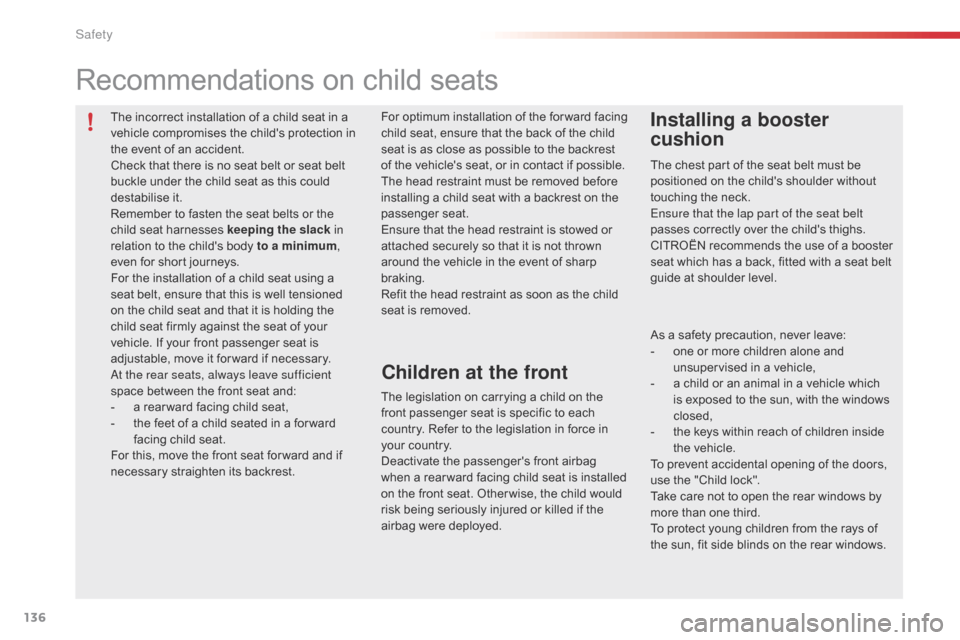
136
The incorrect installation of a child seat in a vehicle compromises the child's protection in
t
he event of an accident.
Check
that there is no seat belt or seat belt
b
uckle under the child seat as this could
de
stabilise
i
t.
Remember
to fasten the seat belts or the
c
hild seat harnesses keeping the slack in
relation
to the child's body to a minimum,
even
for short journeys.
For
the installation of a child seat using a
s
eat belt, ensure that this is well tensioned
o
n the child seat and that it is holding the
c
hild seat firmly against the seat of your
v
ehicle. If your front passenger seat is
a
djustable, move it for ward if necessary.
At the rear seats, always leave sufficient
space
between the front seat and:
-
a
rear ward facing child seat,
-
t
he feet of a child seated in a for ward
f
acing child seat.
For
this, move the front seat for ward and if
n
ecessary straighten its backrest.
Recommendations on child seats
The chest part of the seat belt must be positioned on the child's shoulder without
t
ouching the neck.
Ensure that the lap part of the seat belt
passes
correctly over the child's thighs.
CITROËN
recommends the use of a booster
s
eat which has a back, fitted with a seat belt
g
uide at shoulder level.
As
a safety precaution, never leave:
-
o
ne or more children alone and
u
nsupervised in a vehicle,
-
a
child or an animal in a vehicle which
i
s exposed to the sun, with the windows
c
losed,
-
t
he keys within reach of children inside
t
he vehicle.
To
prevent accidental opening of the doors,
u
se the "Child lock".
Take
care not to open the rear windows by
m
ore than one third.
To
protect young children from the rays of
t
he sun, fit side blinds on the rear windows.
The
legislation
on
carrying
a
child
on
the
f
ront
passenger
seat
is
specific
to
each
c
ountry.
Refer
to
the
legislation
in
force
in
y
our
country.
Deactivate
the
passenger's
front
airbag
w
hen
a
rear ward
facing
child
seat
is
installed
o
n
the
front
seat.
Other wise,
the
child
would
r
isk
being
seriously
injured
or
killed
if
the
a
irbag
were
deployed.
For
o
ptimum
in
stallation
o
f
t
he
fo
rward
f
acing
c
hild
seat,
ensure
that
the
back
of
the
child
s
eat
is
as
close
as
possible
to
the
backrest
o
f
the
vehicle's
seat,
or
in
contact
if
possible.
The
head
restraint
must
be
removed
before
i
nstalling
a
child
seat
with
a
backrest
on
the
p
assenger
sea
t.
Ensure
that
the
head
restraint
is
stowed
or
a
ttached
securely
so
that
it
is
not
thrown
a
round
the
vehicle
in
the
event
of
sharp
b
raking.
Refit
the
head
restraint
as
soon
as
the
child
s
eat
is
removed.
Installing a booster
cushion
Children at the front
Safety
Page 139 of 268
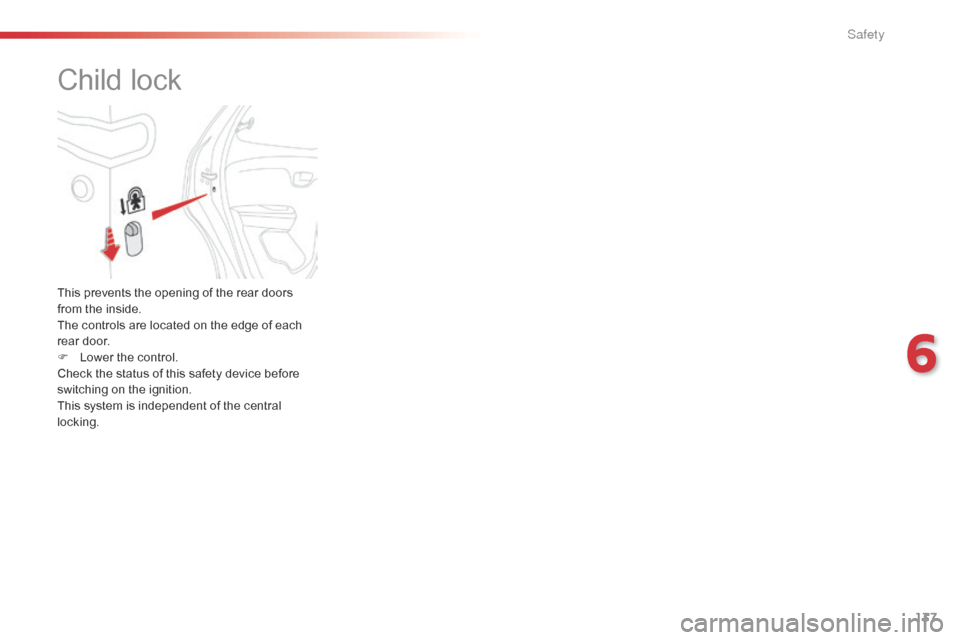
137
Child lock
This prevents the opening of the rear doors from the inside.
The
controls are located on the edge of each
r
ear door.
F
L
ower the control.
Check
the status of this safety device before
s
witching on the ignition.
This
system is independent of the central
l
ocking.
6
S
Page 140 of 268
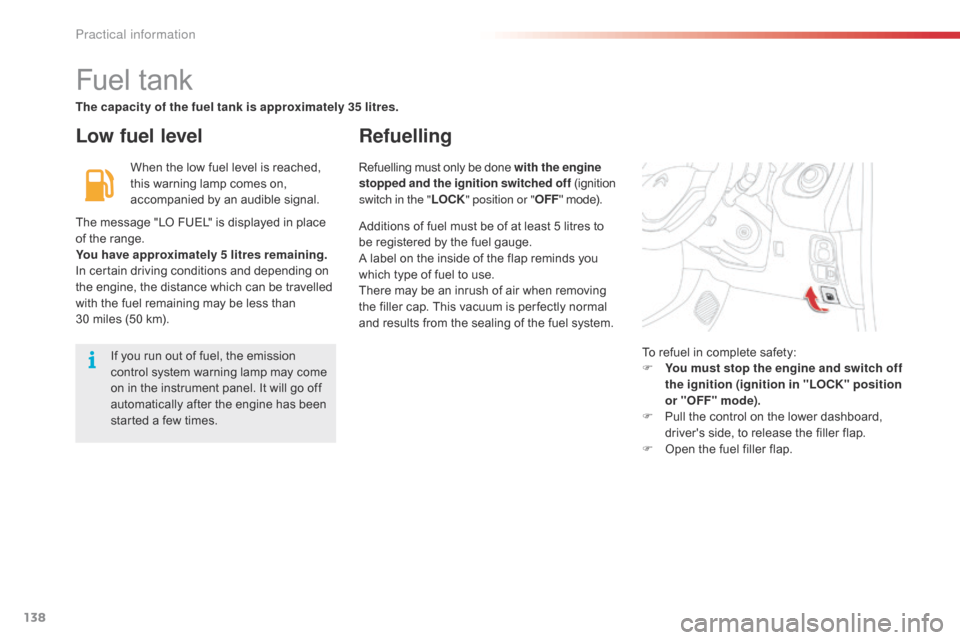
138
Fuel tank
Low fuel levelRefuelling
When the low fuel level is reached, t
his warning lamp comes on,
a
ccompanied by an audible signal.
The
message "LO FUEL" is displayed in place
o
f
the
range.
You have approximately 5 litres remaining.
In
certain
driving conditions and depending on
t
he
engine, the distance which can be travelled
w
ith
the
fuel remaining may be less than
3
0 miles
(50 km). To
refuel in complete safety:
F
Y
ou must stop the engine and switch off
the ignition (ignition in "LOCK" position
or "OFF" mode) .
F
P
ull the control on the lower dashboard,
d
river's side, to release the filler flap.
F
O
pen the fuel filler flap.
If
you run out of fuel, the emission
c
ontrol system warning lamp may come
o
n
in the instrument panel. It will go off
a
utomatically after the engine has been
s
tarted a few times. Refuelling
must only be done with the engine
stopped and the ignition switched off ( ignition s
witch in the "LOCK" position or " OFF"
mode).
The capacity of the fuel tank is approximately 35 litres.
Additions of fuel must be of at least 5 litres to
b
e registered by the fuel gauge.
A
label on the inside of the flap reminds you
w
hich type of fuel to use.
There
may be an inrush of air when removing
t
he filler cap. This vacuum is per fectly normal
a
nd results from the sealing of the fuel system.
Practical information